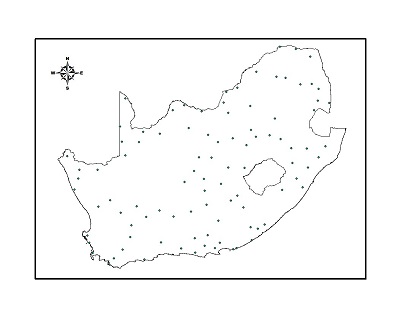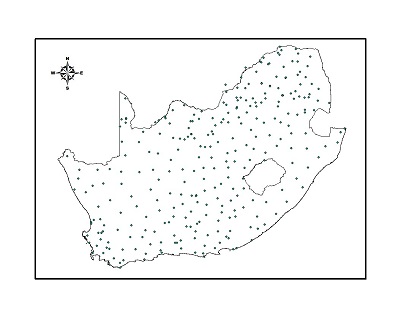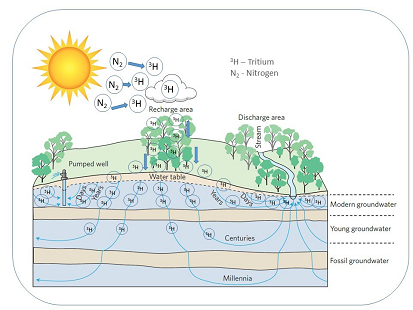This is the question that three postgraduate students from Stellenbosch University (SU) want to answer by collecting as many rainfall and groundwater samples from across the country as they can and they want you, the public, to help.
Dr Jodie Miller, an isotope geochemist in SU's Department of Earth Sciences and the project leader, says South Africans tend to turn to groundwater during periods of drought to compensate for insufficient rainfall: "With this project, we want to develop a model to map the distribution of renewable groundwater in South Africa. With this information we can avoid exploitation and rather use this important resource in a sustainable manner."
MSc student Jared van Rooyen and fellow BSc honours students, Yaa Agyare-Dwomoh and Zita Harilall, have now embarked on a crowdfunding and citizen science initiative to fund their project.
Crowdfunding for groundwater research
Starting on 22 February on the South African crowdfunding platform Thundafund, they plan to raise R60 000 to cover the bare necessities for setting up 100 sample locations. But if they can raise R200 000, they will achieve their goal of 300 sample locations as well as acquiring a dip meter. This instrument costs R15 000 and will enable them to accurately measure the depth of the groundwater samples they collect.
Ultimately, the more points they have in their model the more robust and accurate the model will be (see comparison between the two maps below).


The funding will also be used to set up rainfall collectors and sample groundwater from existing boreholes. Citizen scientists' will receive their very own sampling kits as well as the required funding for sending the samples back to Stellenbosch for analysis.
The science behind the project
"The modelling of groundwater resources is not a new thing," explains Dr Miller. "But because South Africa is geologically very complex, we need more site-specific data to accurately model what is happening to our groundwater in different catchments."
She says there is a significant difference between modern groundwater, young groundwater and what hydrogeologists call fossil groundwater. Broadly speaking, modern groundwater is water that has been recharged by rainfall in the last 50 years. Young groundwater has been lying underground for a couple of centuries, while fossil groundwater or deep water has remained untouched for millennia.
It is therefore important to know and understand how regularly groundwater gets recharged to determine whether it is a renewable resource or not. But how do you determine when groundwater was last recharged?
Dr Miller explains: "We use Tritium (3H), the radioactive isotope of hydrogen, to determine when water that enters the groundwater system was last in contact with the atmosphere. Tritium is naturally produced in the stratosphere and is rained out on the earth's surface. Once it enters the groundwater system and becomes isolated from the atmosphere, it decays at a constant rate.
"Therefore, the longer groundwater is isolated from the atmosphere, the lower the tritium concentration. By knowing the concentration of tritium in rainfall and the concentration in a groundwater reservoir, we can predict how regularly the water is being recharged.
"Once we know this, we can model how renewable the resource is as well as how vulnerable it is to variations in climatic conditions, such as a reduction in rainfall."
With such a model, they will be able to identify areas that have renewable groundwater resources for sustainable agricultural developments, as well as those areas where the water resources need to be protected (see graph at the right, adapted from Alley et al, 1998).
We need a long-term groundwater management strategy
Prof. Eugene Cloete, Vice-Rector: Research, Innovation and Postgraduate Studies, says groundwater is incorrectly perceived as an unlimited water resource and hence often abused: "It is of paramount important to understand the groundwater cycle as part of the water cycle in order to manage this valuable water resource."
This project will be a step forward in establishing a sustainable groundwater management strategy for South Africa, adds Miller.
It is also the first crowdfunded and crowdsourced endeavour in South Africa to investigate our groundwater resources.
Captions
[weknowwatergroup.jpg]
Three postgraduate students from Stellenbosch University have embarked on a crowdfunding campaign to raise R200 000 for their research into the sustainability of South Africa's groundwater resources. From the left, MSc student Jared van Rooyen and fellow BSc honours students, Yaa Agyare-Dwomoh and Zita Harilall, with their study leader, Dr Jodie Miller. Photo: Stefan Els
[100samplingpoints.jpg & 300samplingspoints.jpg]
Do you have a borehole on your property? Become a citizen science and participate in this research project from Stellenbosch University to investigate the sustainability of South Africa's groundwater resources. The more points they have in their model the more robust and accurate the model will be. Graphics: Jodie Miller
[groundwatercycle and tritium.png]
Tritium occurs naturally in the stratosphere and is rained out on the earth's surface. Once it enters the groundwater system and becomes isolated from the atmosphere, it decays at a constant rate. The longer groundwater is isolated from the atmosphere, the lower the tritium concentration. By knowing the concentration of tritium in rainfall and the concentration in a groundwater reservoir, scientists can predict how regularly the water is being recharged. Graphic: adapted from Alley et al, 1998.
Media enquiries
Dr Jodie Miller
T: +27 _21 808 3121
E: jmiller@sun.ac.za
Mr Jared van Rooyen
M: +27 72 795 6776
E: 16469003@sun.ac.za
Issued by Wiida Fourie-Basson, Media: Faculty of Science, Stellenbosch University
T: 021 808 2684 E: science@sun.ac.za M: 071 099 5721

